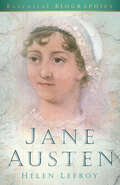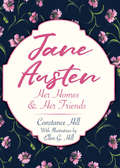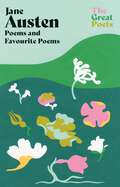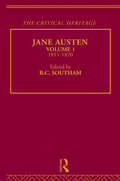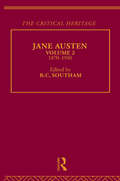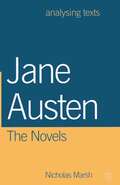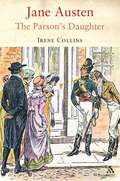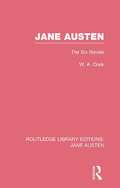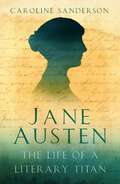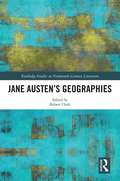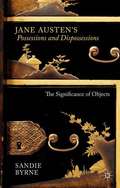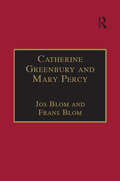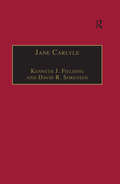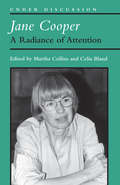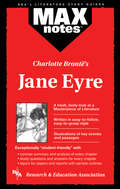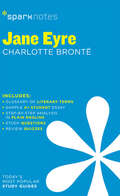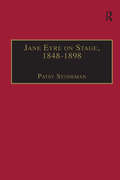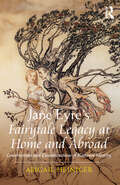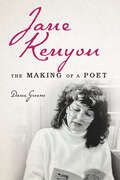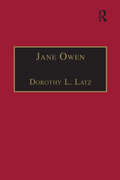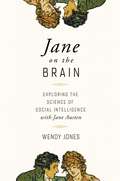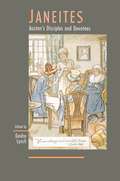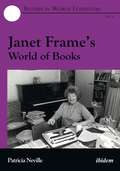- Table View
- List View
Jane Austen: Essential Biographies
by Helen LefroyJane Austen's reputation rests on the six novels she wrote in her short life - enduringly popular novels which have become part of the fabric of English life, and which have reached new audiences through recent dramatisations on screen and stage. This book, which draws on her letters, describes Jane's life in the vicarage at Steventon and later at Bath and Chawton, and her relationships with family and friends - especially her beloved sister, Cassandra, and the engaging Tom Lefroy (who it was rumoured was the love of her life). It also describes the parties and balls in country houses and assembly rooms which she attended and the detail of nineteenth-century life which she so sharply observed and which provided the backgroung to her novels. This book is a pleasure for anyone wanting to understand the life of one of our great novelists.
Jane Austen: Her Homes and Her Friends
by Constance Hill Ellen G. HillOn a sunny September morning more than a century ago, a horse and buggy bearing two sisters wound its way past green pastures and wooded hills to the narrow streets of a Hampshire village. Constance and Ellen Hill, a pair of passionate admirers of Jane Austen, sat prepared to take the first steps in retracing the life of their idol. This charmingly written and illustrated account of their literary pilgrimage begins in Steventon, Jane Austen's birthplace, and extends to Bath, Lyme, Southampton, London, and elsewhere before concluding at the author's burial place in Winchester Cathedral. Along the way, it offers insights into the connections between the author's experiences and those of the characters in her novels. <P><P> Constance and Ellen Hill were given access to manuscripts of Austen's letters, unpublished family memoirs, and notebooks containing the "Minor Works," as well as the loan of family portraits, pictures, and contemporary sketches. Their fascinating glimpse of Austen's world, originally published in 1902, abounds in the same enthusiasm that draws Janeites to the author. "The more intimate their knowledge of her character becomes," the Preface promises readers, "the more must they admire and love her rare spirit."
Jane Austen: Poems both inspiring and witty from the author of 'Pride and Prejudice' and 'Emma' (The Great Poets)
by Jane Austen'Another world must be unfurled, Another language known'Best known - and beloved - for her highly popular novels including Pride and Prejudice, Emma and Sense and Sensibility, Jane Austen was also an accomplished, and often witty, poet:'I am going to have my dinner, after which I shan't be thinner'This collection, which also includes poems by the poets she herself admired, sheds light not only on Jane Austen the writer, but on the themes that are woven through her bestselling novels. Satirical, humorous and ironical, they will resonate both with readers who love her novels, and newcomers alike.'When stretched out on one's bed with a fierce throbbing head ... how little one cares for the grandest affairs''I am in a dilemma, for want of an Emma'
Jane Austen: Poems both inspiring and witty from the author of 'Pride and Prejudice' and 'Emma' (The Great Poets)
by Jane Austen'Another world must be unfurled, Another language known'Best known - and beloved - for her highly popular novels including Pride and Prejudice, Emma and Sense and Sensibility, Jane Austen was also an accomplished, and often witty, poet:'I am going to have my dinner, after which I shan't be thinner'This collection, which also includes poems by the poets she herself admired, sheds light not only on Jane Austen the writer, but on the themes that are woven through her bestselling novels. Satirical, humorous and ironical, they will resonate both with readers who love her novels, and newcomers alike.'When stretched out on one's bed with a fierce throbbing head ... how little one cares for the grandest affairs''I am in a dilemma, for want of an Emma'
Jane Austen: Reflections of a Reader
by By Nora Bartlett. Edited by Jane StablerThis volume presents an exhilarating and insightful collection of essays on Jane Austen – distilling the author’s deep understanding and appreciation of Austen’s works across a lifetime. The volume is both intra- and inter-textual in focus, ranging from perceptive analysis of individual scenes to the exploration of motifs across Austen’s fiction.
Jane Austen: The Critical Heritage Volume 1 1811-1870 (Critical Heritage Ser.)
by B. C. SouthamThe Critical Heritage gathers together a large body of critical sources on major figures in literature. Each volume presents contemporary responses to a writer's work, enabling student and researcher to read the material themselves.
Jane Austen: The Critical Heritage Volume 2 1870-1940 (Critical Heritage Ser.)
by B. C. SouthamThe Critical Review brings together a large body of critical sources on major figures in literature. Each volume presents contemporary responses to a writer's work, enabling student and researcher to read the material themselves.
Jane Austen: The Novels (Analysing Texts)
by Nicholas MarshJane Austen's novels--Pride and Prejudice, Emma, Mansfield Park, andPersuasion --are among the most polished, carefully crafted works in the English literary heritage. This book takes extracts and examines them in close detail, bringing out the extraordinary richness of irony and implication in Jane Austen's writing. Through textual analysis, the reader is taught to explore and enjoy the delicate comedy of her narratives and to inquire into the serious moral purpose that lies behind each of the four novels. This guide does not simplify the study of Jane Austen, but invites the reader to join in, pursuing and revelling in the ironic subtlety of her methods and thought.
Jane Austen: The Parson's Daughter
by Irene CollinsJane Austen was a clergyman's daughter, related to other clergy, born and brought up in a parsonage. Many of her attitudes, expressed in her novels, reflect this directly or indirectly. Her father's reasoned and practical approach to religion, along with the range of books available to her in his library, shaped the essentially moral outlook behind her entertaining, but devastating, criticism of individuals and of society. Her attitude to the gentry is subtly ambivalent. Accepted as a clergyman's daughter in local society, Jane Austen sometimes mirrors their prejudices, seen for instance in her characterisation of the haughty aristocrat Lady Catherine de Bourgh in Pride and Prejudice. At the same time, her own marginal position in gentry society gave her personal experience of the slights and snobberies inherent in the subtle class distinctions of the time. As the years went by, she became more and more sensitive about the position of women without money of their own, and wrote feelingly in Emma of the lowered status of a parson's daughter who has died. Jane Austen's life coincided with her country's war against Revolutionary France. It has often seemed surprising that she never mentions war explicitly in her novels, especially as two of her brothers were officers in the navy and another in the militia. Jane Austen: The Parson's Daughter shows how Jane Austen in fact drew on an extensive knowledge of wartime conditions not only in Pride and Prejudice with its militia regiment, and in Mansfield Park and Persuasion with their sailors, but also in Sense and Sensibility, Northanger Abbey and even Emma - though the latter never moves outside the village of Highbury.
Jane Austen: The Six Novels (Routledge Library Editions: Jane Austen)
by Wendy CraikFirst published in 1965, this reissued work by Wendy Craik provides a thorough and extensive study of Jane Austen's six complete novels: Northanger Abbey, Sense and Sensibility, Pride and Prejudice, Mansfield Park, Emma and Persuasion. This is a truly groundbreaking study of Austen which, in addition to a close analysis of the novels themselves, also goes on investigate the principles by which Jane Austen selected and arranged her material.
Jane Austen: pocket GIANTS (Pocket GIANTS)
by Caroline SandersonThere’s something about Jane… Jane Austen lived only just into her forties, never married, never had children, lived all her life in the south of England and rarely strayed far from the genteel and orthodox social circle into which she was born. She completed only six novels, and achieved little fame in her lifetime. Yet 200 years after her death, she remains one of our most revered writers, and one of the most regularly adapted for television and film. Her novels are beloved by readers all over the world who continue to be inspired, beguiled and delighted by her often comic, and always shrewd insights into the calculations, and complexities of human hearts and minds. This short biography aims to get to the heart of the enigmatic woman who was Jane Austen, and to the enduring qualities in her work which make it so universally loved and admired.
Jane Austen’s Geographies (Routledge Studies in Nineteenth Century Literature)
by Robert ClarkWhen Jane Austen represented the ideal subject for a novel as "three or four families in a country village", rather than encouraging a narrow range of reference she may have meant that a tight focus was the best way of understanding the wider world. The essays in this collection research the historical significance of her many geographical references and suggest how contemporaries may have read them, whether as indications of the rapid development of national travel, or of Britain’s imperial status, or as signifiers of wealth and social class, or as symptomatic of political fears and aspirations. Specifically, the essays consider the representation of colonial mail-order wives and naval activities in the Mediterranean, the worrisome nomadism of contemporary capitalism, the complexity of her understanding of the actual places in which her fictions are set, her awareness of and eschewal of contemporary literary conventions, and the burden of the Austen family’s Kentish origins, the political implications of addresses in London and Northamptonshire. Skilful, detailed, and historically informed, these essays open domains of meaning in Austen’s texts that have often gone unseen by later readers but which were probably available to her coterie readers and clearly merit much closer critical attention.
Jane Austen’s Possessions and Dispossessions
by Sandie ByrneWho owns, who buys, who gives, and who notices objects is always significant in Austen's writing, placing characters socially and characterizing them symbolically. Jane Austen's Possessions and Dispossessions looks at the significance of objects in Austen's major novels, fragments, and juvenilia.
Jane Barker: Printed Writings 1641–1700: Series II, Part Four, Volume 1 (The Early Modern Englishwoman: A Facsimile Library of Essential Works & Printed Writings, 1641-1700: Series II, Part Four)
by Robert C. EvansJane Barker (1652-1732) is increasingly being recognised as one of the most important English women writers of the late-seventeenth and early-eighteenth centuries. The author of both poems and novels (including novels containing numerous poems), Barker was largely ignored for many years but has recently been the subject of intense interest and investigation. Despite this, no complete, collected edition of Barker's poems has yet appeared, and the present volume is the first reproduction of her important early published volume, Poetical Recreations, to be issued in facsimile as a printed book (rather than on microfilm). Jane Barker's life was rich in incident. Her early poetry was enthusiastically advocated by the male students at St. John's College, Cambridge. A persecuted Catholic and a subsequent longtime exiled supporter of the Jacobite cause in France following the 'Bloodless Revolution', she was also physically disabled and without great financial means, in part because she never married. Almost certainly her decision to begin publishing novels was motivated, on some level, by financial need. By the time she died, in March 1732, at the age of seventy-nine, she had lived a life that had been long, eventful, and accomplished, but by no means easy.
Jane Carlyle: Newly Selected Letters (The Nineteenth Century Series)
by Kenneth J. FieldingThis new selection of the letters of Jane Welsh Carlyle presents a complete view of a remarkable Victorian woman, with a wide circle of friends, who enjoyed the company of distinguished thinkers, writers, politicians, feminists, eccentrics and radicals. This edition draws on many remarkable letters and papers not published before, in which she created a memorable epistolary voice - shrewd, vigorous, ironic, observant, humorous and passionate. Previous selections have often tamely followed the semi-mythical version of her life first given by Carlyle’s biographer, James Anthony Froude, showing her as the victimized angel in distress. This new selection gives a rounded picture of her complex character, showing her as a tormented yet forceful woman who was a strong personality in her own right. She now emerges as a self-conscious artist, adept at constructing images of herself that were designed to appeal to her particular correspondents. The account is written with close attention to Jane Carlyle's long-running jealousy of Lady Harriet Ashburton; and fresh letters include many to her mother and her vital response to her passionate lover or admirer Charlotte Cushman. Each letter is a tightly controlled performance, which justifies Thomas Carlyle’s belief that her letters equal and surpass whatever of best I know to exist in that kind.
Jane Cooper: A Radiance of Attention (Under Discussion)
by Martha Collins Celia BlandThough she published only five volumes of poetry over the course of her career, Jane Cooper (1924–2007) was deeply admired by her contemporaries, and teaching at Sarah Lawrence College for nearly forty years, she served as a mentor to many aspiring poets. Her elegant, honest, and emotionally and formally precise poems, often addressing the challenges of women’s lives—especially the lives of women in the arts—continue to resonate with a new generation of readers. Martha Collins and Celia Bland bring together several decades’ worth of essential writing on Cooper’s poetry. While some pieces offer close examination of Cooper’s process or thoughtful consideration of the craft of a single poem, the volume also features reviews of her collections, including a previously unpublished piece on her first book, The Weather of Six Mornings (1969), by James Wright, a lifelong champion of her work. Marie Howe, Jan Heller Levi, and Thomas Lux, among others, share personal remembrances of Cooper as a teacher, colleague, and inspiration. L. R. Berger’s moving tribute to Cooper’s final days closes the volume. This book has much to offer for both readers who already love Cooper’s work and new readers, especially among younger poets, just discovering her enduring poems.
Jane Eyre (MAXnotes Literature Guides)
by Barbara QuinteroREA's MAXnotes for Charlotte Bronte's Jane Eyre MAXnotes offer a fresh look at masterpieces of literature, presented in a lively and interesting fashion. Written by literary experts who currently teach the subject, MAXnotes will enhance your understanding and enjoyment of the work. MAXnotes are designed to stimulate independent thought about the literary work by raising various issues and thought-provoking ideas and questions. MAXnotes cover the essentials of what one should know about each work, including an overall summary, character lists, an explanation and discussion of the plot, the work's historical context, illustrations to convey the mood of the work, and a biography of the author. Each chapter is individually summarized and analyzed, and has study questions and answers.
Jane Eyre SparkNotes Literature Guide (SparkNotes Literature Guide Series #37)
by SparkNotesJane Eyre SparkNotes Literature Guide by Charlotte Bronte Making the reading experience fun! When a paper is due, and dreaded exams loom, here's the lit-crit help students need to succeed! SparkNotes Literature Guides make studying smarter, better, and faster. They provide chapter-by-chapter analysis; explanations of key themes, motifs, and symbols; a review quiz; and essay topics. Lively and accessible, SparkNotes is perfect for late-night studying and paper writing. Includes:An A+ Essay—an actual literary essay written about the Spark-ed book—to show students how a paper should be written.16 pages devoted to writing a literary essay including: a glossary of literary termsStep-by-step tutoring on how to write a literary essayA feature on how not to plagiarize
Jane Eyre on Stage, 1848–1898: An Illustrated Edition of Eight Plays with Contextual Notes (The Nineteenth Century Series)
by Patsy StonemanCharlotte Brontë's Jane Eyre was published in October, 1847, and within three months a version was on stage in London. By 1900, at least eight different stage versions had appeared in England, America and continental Europe. For the first time, all eight plays are available in Patsy Stoneman's critical edition, richly illustrated by facsimile reproductions of manuscripts, unique Victorian playbills, contemporary etchings of theatres, and portraits of playwrights and actors. Stoneman's introduction places the plays' bizarre innovations in the context of theatre history and of contemporary debates on class and gender, while each edited play-text is accompanied by detailed notes, based on original research, on the playwright, theatre(s) and performances, and contemporary reception. Most of these plays existed only in manuscript, and were quickly forgotten, yet they make fascinating reading. Nineteenth-century playwrights had no reverence for a text we regard as canonical, but added to, deleted from and twisted Charlotte Brontë's story to suit their own purposes. One play has a cast of comic servants who follow Jane from Lowood to Thornfield. In another, the madwoman is revealed as the sister-in-law of a blameless Rochester. A third has Blanche Ingram reduced to a fallen woman, seduced and abandoned by John Reed. Jane Eyre on Stage will appeal to readers interested in literary and theatrical history, cultural studies, and the intriguing afterlives of famous books.
Jane Eyre's Fairytale Legacy at Home and Abroad: Constructions and Deconstructions of National Identity
by Abigail HeinigerExploring the literary microcosm inspired by Brontë's debut novel, Jane Eyre's Fairytale Legacy at Home and Abroad focuses on the nationalistic stakes of the mythic and fairytale paradigms that were incorporated into the heroic female bildungsroman tradition. Jane Eyre, Abigail Heiniger argues, is a heroic changeling indebted to the regional, pre-Victorian fairy lore Charlotte Brontë heard and read in Haworth, an influence that Brontë repudiates in her last novel, Villette. While this heroic figure inspired a range of female writers on both sides of the Atlantic, Heiniger suggests that the regional aspects of the changeling were especially attractive to North American writers such as Susan Warner and L.M. Montgomery who responded to Jane Eyre as part of the Cinderella tradition. Heiniger contrasts the reactions of these white women writers with that of Hannah Crafts, whose Jane Eyre-influenced The Bondwoman's Narrative rejects the Cinderella model. Instead, Heiniger shows, Crafts creates a heroic female bildungsroman that critiques fairytale narratives from the viewpoint of the obscure, oppressed workers who remain forever outside the tales of wonder produced for middle-class consumption. Heiniger concludes by demonstrating how Brontë's middle-class American readers projected the self-rise ethic onto Jane Eyre, miring the novel in nineteenth-century narratives of American identity formation.
Jane Kenyon: The Making of a Poet
by Dana GreeneDemystifying the “Poet Laureate of Depression” Pleasure-loving, sarcastic, stubborn, determined, erotic, deeply sad--Jane Kenyon’s complexity and contradictions found expression in luminous poems that continue to attract a passionate following. Dana Greene draws on a wealth of personal correspondence and other newly available materials to delve into the origins, achievement, and legacy of Kenyon’s poetry and separate the artist’s life story from that of her husband, the award-winning poet Donald Hall. Impacted by relatives’ depression during her isolated childhood, Kenyon found poetry at college, where writers like Robert Bly encouraged her development. Her graduate school marriage to the middle-aged Hall and subsequent move to New Hampshire had an enormous impact on her life, moods, and creativity. Immersed in poetry, Kenyon wrote about women’s lives, nature, death, mystical experiences, and melancholy--becoming, in her own words, an “advocate of the inner life.” Her breakthrough in the 1980s brought acclaim as “a born poet” and appearances in the New Yorker and elsewhere. Yet her ongoing success and artistic growth exacerbated strains in her marriage and failed to stave off depressive episodes that sometimes left her non-functional. Refusing to live out the stereotype of the mad woman poet, Kenyon sought treatment and confronted her illness in her work and in public while redoubling her personal dedication to finding pleasure in every fleeting moment. Prestigious fellowships, high-profile events, residencies, and media interviews had propelled her career to new heights when leukemia cut her life short and left her husband the loving but flawed curator of her memory and legacy. Revelatory and insightful, Jane Kenyon offers the first full-length biography of the elusive poet and the unquiet life that shaped her art.
Jane Owen: Printed Writings 1500–1640: Series I, Part Two, Volume 9 (The Early Modern Englishwoman: A Facsimile Library of Essential Works & Printed Writings, 1500-1640: Series I, Part Two)
by Dorothy L. LatzFew facts are known about Catholic recusant Jane Owen. The title page of this, her only work, tells us that in 1634 when this volume was published at St Omer, she was already deceased. However, she was necessarily still living after 1617 when the treatise of Bellarmine, which she here partially translates and comments on, De Gemitu Columbae, was first published. It seems likely that she spent most of her life in England but later lived in exile on the Continent, possibly returning regularly to collect alms for poverty stricken English recusants abroad. Her simple prose gives us unique glimpses of social history written by a recusant woman in the first person.
Jane on the Brain: Exploring The Science Of Social Intelligence With Jane Austen
by Wendy JonesAn Austen scholar and therapist reveals Jane Austen's intuitive ability to imbue her characters with hallmarks of social intelligence—and how these beloved works of literature can further illuminate the mind-brain connection. Why is Jane Austen so phenomenally popular? Why do we read Pride and Prejudice again and again? Why do we delight in Emma’s mischievous schemes? Why do we care that Anne Elliot of Persuasion suffers? We care because it is our biological destiny to be interested in people and their stories—the human brain is a social brain. And Austen’s characters are so believable, that for many of us, they are not just imaginary beings, but friends whom we know and love. And thanks to Austen's ability to capture the breadth and depth of human psychology so thoroughly, we feel that she empathizes with us, her readers. Humans have a profound need for empathy, to know that we are not alone with our joys and sorrows. And then there is attachment, denial, narcissism, and of course, love, to name a few. We see ourselves and others reflected in Austen’s work. Social intelligence is one of the most highly developed human traits when compared with other animals How did is evolve? Why is it so valuable? Wendy Jones explores the many facets of social intelligence and juxtaposes them with the Austen cannon. Brilliantly original and insightful, this fusion of psychology, neuroscience, and literature provides a heightened understanding of one of our most beloved cultural institutions—and our own minds.
Janeites: Austen's Disciples and Devotees
by Deidre LynchOver the last decade, as Jane Austen has moved center-stage in our culture, onto best-seller lists and into movie houses, another figure has slipped into the spotlight alongside her. This is the "Janeite," the zealous reader and fan whose devotion to the novels has been frequently invoked and often derided by the critical establishment. Jane Austen has long been considered part of a great literary tradition, even legitimizing the academic study of novels. However, the Janeite phenomenon has not until now aroused the curiosity of scholars interested in the politics of culture. Rather than lament the fact that Austen today shares the headlines with her readers, the contributors to this collection inquire into why this is the case, ask what Janeites do, and explore the myriad appropriations of Austen--adaptations, reviews, rewritings, and appreciations--that have been produced since her lifetime. The articles move from the nineteenth-century lending library to the modern cineplex and discuss how novelists as diverse as Cooper, Woolf, James, and Kipling have claimed or repudiated their Austenian inheritance. As case studies in reception history, they pose new questions of long-loved novels--as well as new questions about Austen's relation to Englishness, about the boundaries between elite and popular cultures and amateur and professional readerships, and about the cultural work performed by the realist novel and the marriage plot. The contributors are Barbara M. Benedict, Mary A. Favret, Susan Fraiman, William Galperin, Claudia L. Johnson, Deidre Lynch, Mary Ann O'Farrell, Roger Sales, Katie Trumpener, and Clara Tuite.
Janet Frame’s World of Books (Studies in World Literature #8)
by Patricia NevilleThis study investigates how Janet Frame weaves together literary sources from her extensive reading to create a web of intertextual relationships. Patricia Neville traces Frame’s passion for books beginning with her childhood and earliest published work in the Otago Daily Times. Drawing on new research and through close readings of Frame’s novels, she discusses the effects of Frame’s borrowings from the Bible and Shakespeare and from writing from New Zealand, Britain, France, and the United States. It is a fascinating read not only for scholars but for all admirers of Frame’s fiction.
